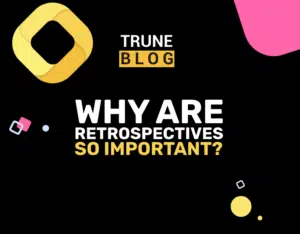Top 5 Methods To Boost Engagement During Your Retrospectives:
As a scrum master, one of your primary responsibilities is hosting retrospectives. Retrospectives are essential components of the agile process and give teams a chance to reflect on what went well and not so well during a sprint. Unfortunately, getting them engaged and open during these discussions can be challenging. In this blog post we’ll look at some tips for increasing engagement levels and encouraging your team members to share insights during retrospectives.
Creating a Safe Space
One of the most essential tasks a scrum master has is creating a safe environment for your team during retrospectives. This means creating an atmosphere in which members feel confident sharing their ideas without fear of judgement or retribution. To start creating such an atmosphere, set ground rules at the start of the retrospective and encourage everyone to speak openly and honestly; stressing that all feedback is valuable and appreciated. Furthermore, keep the conversation focused on the team and sprint rather than individuals.
But how do we actually achieve that?
Establish Expectations: At the start of your retrospective, make it clear to everyone that the purpose is to collect feedback and identify areas for improvement. Reinforce that all input is valued, creating a safe atmosphere to share thoughts and ideas.
Encourage Active Listening: Instruct your team members to practice active listening and avoid interrupting or dismissing each other’s ideas. When people feel that their opinions are being heard and valued, they are more likely to feel comfortable sharing their thoughts and strategies.
Stress Confidentiality: Remind your team that anything discussed during a retrospective meeting remains confidential. Reiterate that any feedback or issues shared will be used to enhance performance, not assign blame or assign blame.
Be Respectful and Non-Judgemental: Throughout the retrospective, show respect to all team members and their opinions. Avoid being judgmental or dismissive of any feedback or ideas shared during the meeting. Create an atmosphere where everyone feels comfortable expressing their ideas without fear of judgement or criticism.
Focus on the Process, Not the Person: When discussing areas for improvement, remember to focus on the process rather than any individual team member. Avoid assigning blame or singling out any individual member; rather, identify ways to enhance overall team performance.
Finally, make sure to follow up on any action items that come out of the retrospective meeting. When team members feel their feedback is valued and action taken based on it, they are more likely to continue participating in future meetings.
Utilize Icebreakers
Icebreakers are an excellent way to get your team engaged and break the ice at the beginning of a retrospective. There are various icebreakers you can use, from straightforward ones like „two truths and a lie“ to more complex ones like „speed dating.“ Ultimately, select an icebreaker that works for your group so everyone feels comfortable and engaged during their discussion.
Keep It Positive
Retrospectives should always be a positive experience, even when there are unpleasant topics to discuss. Focus on the positive aspects of the sprint and use the retrospective as an opportunity to celebrate your team’s successes. Doing this helps create an upbeat atmosphere and encourages team members to express themselves honestly and openly about their thoughts and ideas.
Encourage Participation
Promoting participation during retrospectives is essential for getting your team to open up during these important discussions. Make sure everyone has a chance to speak and no one dominates the conversation. Encourage quieter members of your team to contribute their thoughts and ideas, as well as acknowledge and value everyone’s contributions. Let’s explore some ways to encourage participation in more detail:
>Establish Expectations: Prior to beginning the retrospective, make it clear to your team that their participation is essential for its success. Emphasize that you want everyone’s input and encourage them to contribute their thoughts and ideas honestly and openly.
Use Round-Robin: One effective technique for increasing participation is using a round-robin format. In this scenario, you go around the room and ask each team member to share their thoughts on the sprint. This ensures everyone has their turn to speak, helping quieter members feel more at ease sharing their opinions.
Break into Smaller Groups: If your team is large, it may be difficult for everyone to join a discussion in one room. Consider breaking the group into three to five smaller groups and asking each group to focus on discussing specific topics separately. Afterward, bring everyone back together so everyone can share their findings with the larger group.
Use Anonymous Feedback: Some team members may feel reluctant to offer open feedback, particularly if they worry about how it will be received. Consider using anonymous feedback techniques such as a suggestion box or online survey to gather opinions from those on your team who may feel more secure giving their views anonymously in a group setting.
Celebrate Participation: Finally, acknowledge and thank team members who take part in the retrospective meeting. Express appreciation for their contributions and follow up on any action items that come out of it. When team members feel valued for their opinions and see that action is being taken based on them, they are more likely to continue participating in future meetings.
Utilize Visual Aids
Visual aids are an excellent way for the team to visualize their progress and identify areas for improvement. This could range from a whiteboard with sticky notes to something as complex as a Kanban board. Visual aids help keep teams motivated and focused during retrospectives, making the experience more interactive and captivating for everyone involved.
Everything visual helps. Use some GIFs during your Ice Breaker phase. Use templates or a tool with graphics for the desired outcome. Show some diagrams or charts. Try to spice things up by introducing or trying something else every other week.
In conclusion, improving engagement and getting your team to open up during retrospectives is paramount for the success of agile. By creating a safe space, using icebreakers, focusing on what’s positive, encouraging participation, and using visual aids during these gatherings you can help create an productive yet engaging retrospective that will enable your team to improve and thrive.







